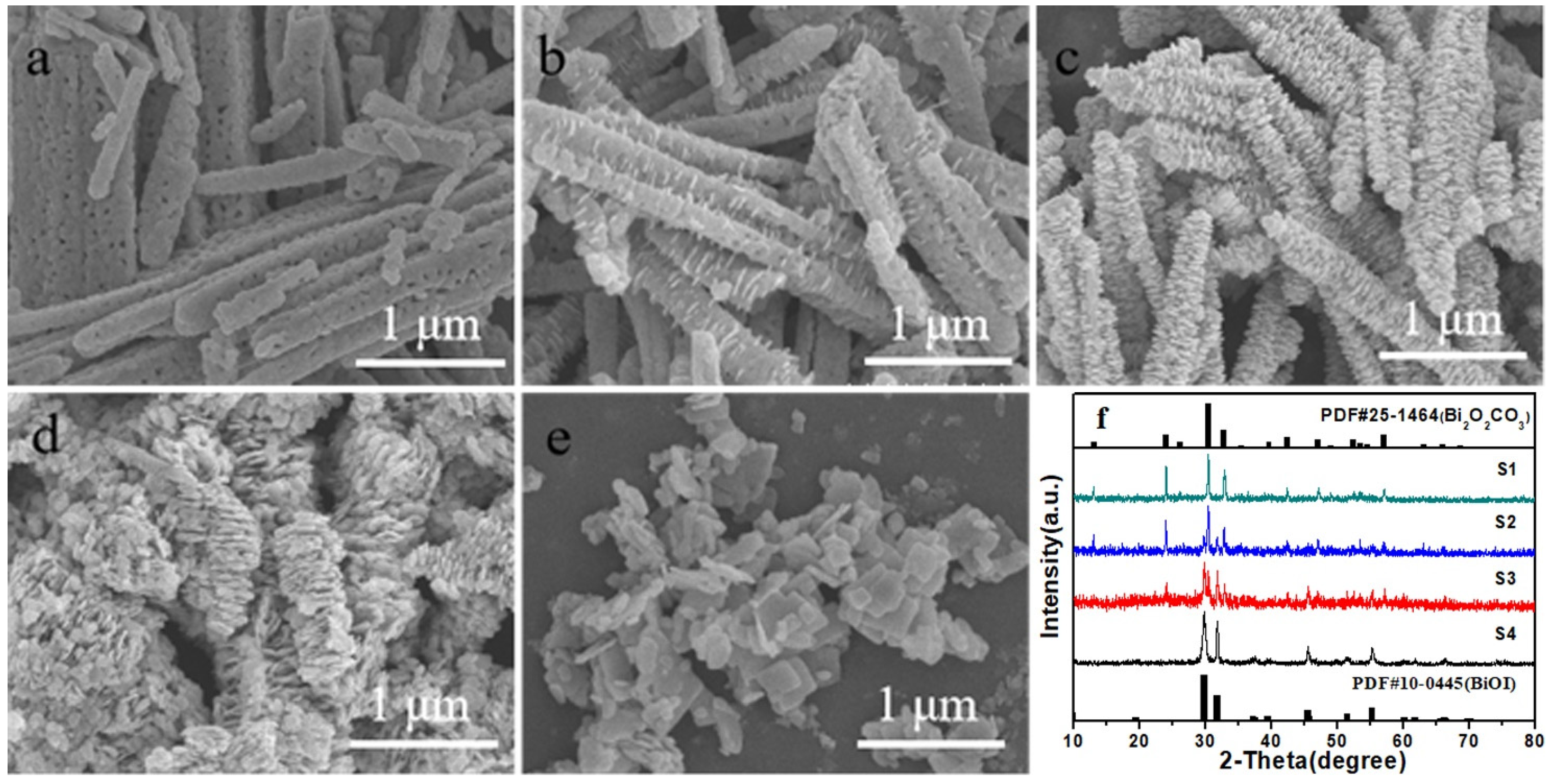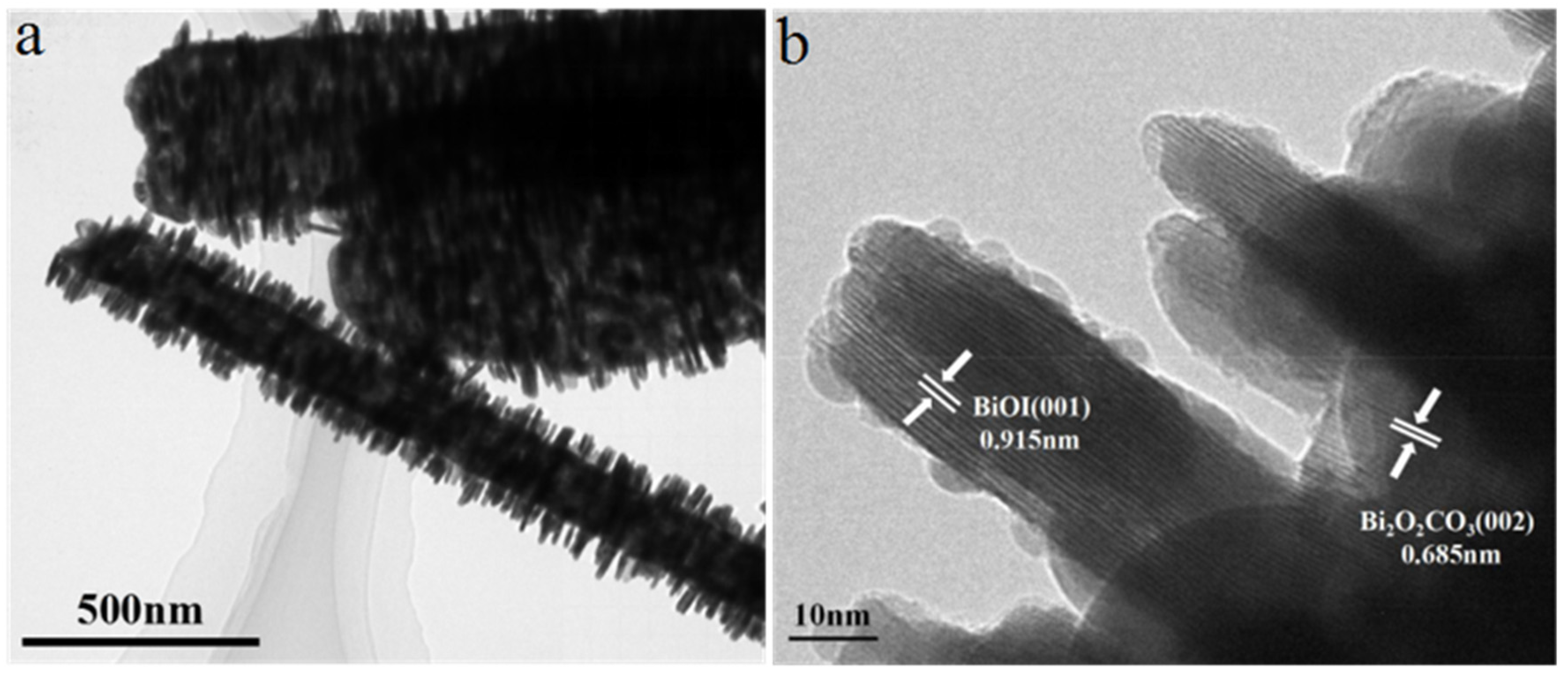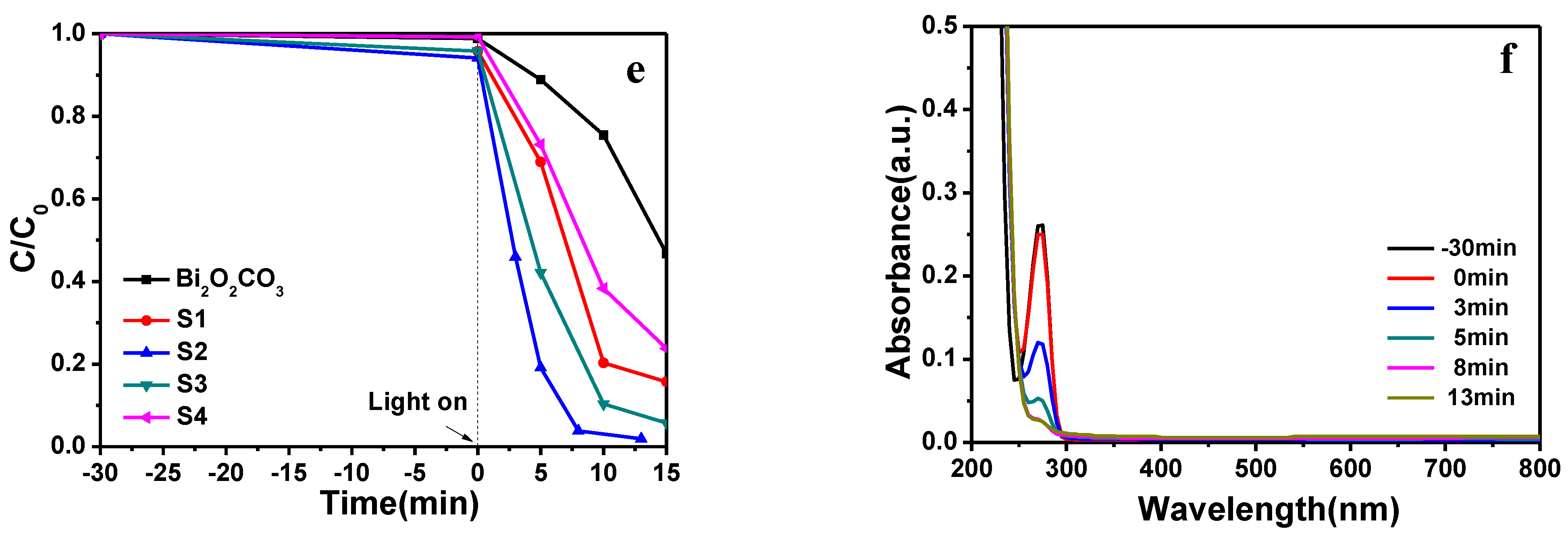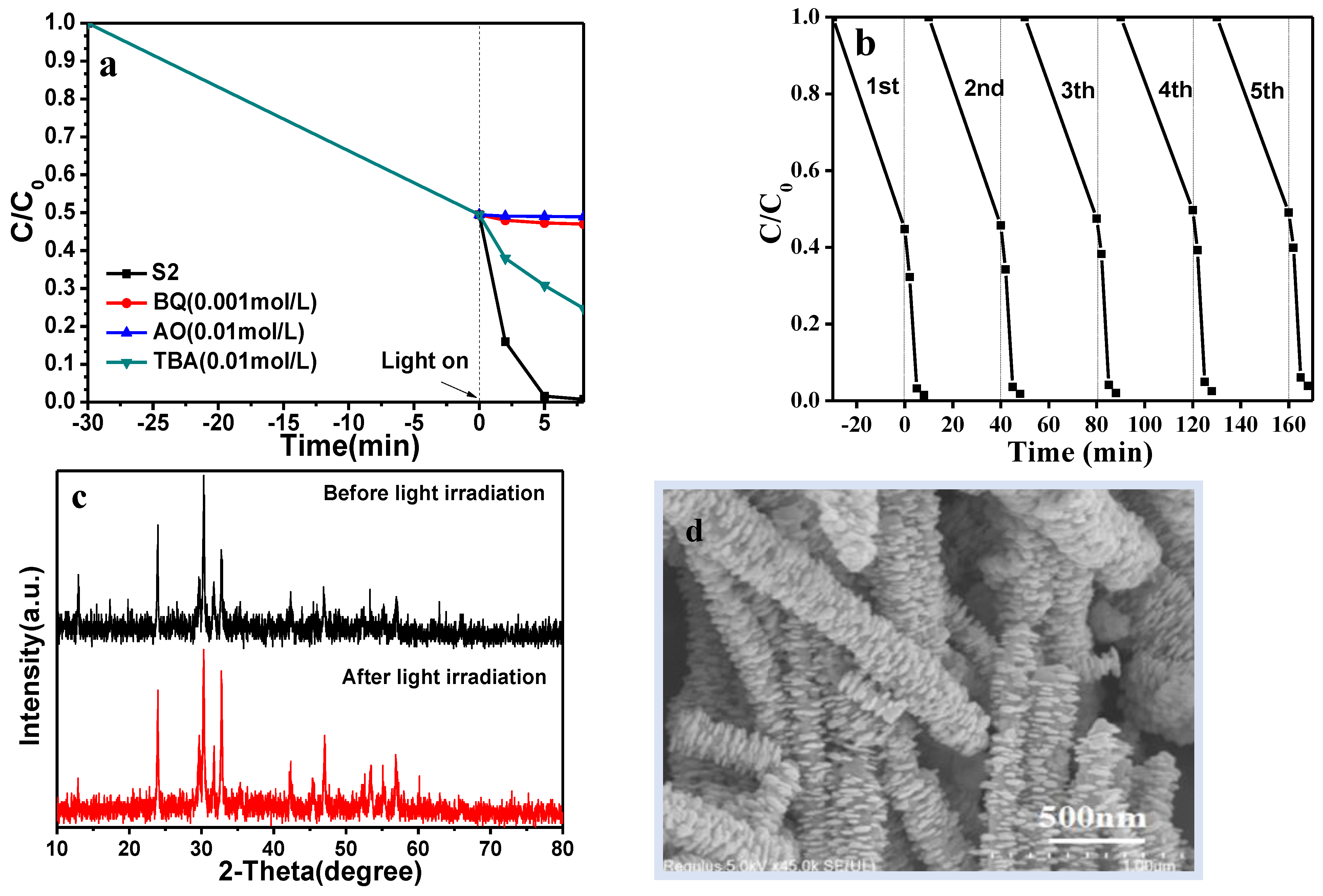Synthesis of a Novel 1D/2D Bi2O2CO3–BiOI Heterostructure and Its Enhanced Photocatalytic Activity
Abstract
:1. Introduction
2. Results and Discussion
3. Experimental
3.1. Photocatalyst Preparation
3.2. Photocatalytic Activity Measurements
3.3. Electrochemical Impedance Spectroscopy (EIS) Measurements
3.4. Characterization
4. Conclusions
Supplementary Materials
Author Contributions
Funding
Acknowledgments
Conflicts of Interest
References
- Feng, X.; Wang, P.; Hou, J.; Qian, J.; Wang, C.; Ao, Y. Oxygen vacancies and phosphorus codoped black titania coated carbon nanotube composite photocatalyst with efficient photocatalytic performance for the degradation of acetaminophen under visible light irradiation. Chem. Eng. 2018, 352, 947–956. [Google Scholar] [CrossRef]
- Lashgari, M.; Zeinalkhani, P. Ammonia photosynthesis under ambient conditions using an efficient nanostructured FeS2/CNT solar-energy-material with water feedstock and nitrogen gas. Nano Energy 2018, 48, 361–368. [Google Scholar] [CrossRef]
- Xu, H.-M.; Wang, H.-C.; Shen, Y.; Lin, Y.-H.; Nan, C.-W. Low-dimensional nanostructured photocatalysts. J. Adv. Ceram. 2015, 4, 159–182. [Google Scholar] [CrossRef] [Green Version]
- Azami, M.; Haghighi, M.; Allahyari, S. Sono-precipitation of Ag2CrO4-C composite enhanced by carbon-based materials (AC, GO, CNT and C3N4) and its activity in photocatalytic degradation of acid orange 7 in water. Ultrason. Sonochem 2018, 40, 505–516. [Google Scholar] [PubMed]
- Chaudhary, D.; Vankar, V.D.; Khare, N. Noble metal-free g-C3N4/TiO2/CNT ternary nanocomposite with enhanced photocatalytic performance under visible-light irradiation via multi-step charge transfer process. Sol. Energy 2017, 158, 132–139. [Google Scholar] [CrossRef]
- He, Z.; Byun, J.-H.; Zhou, G.; Park, B.-J.; Kim, T.-H.; Lee, S.-B.; Yi, J.-W.; Um, M.-K.; Chou, T.-W. Effect of MWCNT content on the mechanical and strain-sensing performance of Thermoplastic Polyurethane composite fibers. Carbon 2019, 146, 701–708. [Google Scholar] [CrossRef]
- Zhong, Y.; Peng, C.; He, Z.; Chen, D.; Jia, H.; Zhang, J.; Ding, H.; Wu, X. Interface engineering of heterojunction photocatalysts based on 1D nanomaterials. Catal. Sci. Technol. 2021, 11, 27–42. [Google Scholar] [CrossRef]
- Chen, X.; Zhang, J.; Zeng, J.H.; Shi, Y.X.; Lin, S.Y.; Huang, G.Z.; Wang, H.B.; Kong, Z.; Xi, J.H.; Ji, Z.G. MnS coupled with ultrathin MoS2 nanolayers as heterojunction photocatalyst for high photocatalytic and photoelectrochemical activities. J. Alloy. Compd. 2019, 771, 364–372. [Google Scholar] [CrossRef]
- Fan, X.B.; Zhang, G.L.; Zhang, F.B. Multiple roles of graphene in heterogeneous catalysis. Chem. Soc. Rev. 2015, 44, 3023–3035. [Google Scholar] [CrossRef] [PubMed]
- Aradi, E.; Erasmus, R.M.; Derry, T.E. Formation of c-BN nanoparticles by helium, lithium and boron ion implantation. Nucl. Instrum. Meth. B 2012, 272, 57–60. [Google Scholar] [CrossRef]
- Cao, X.; Jiang, C.; Tan, D.; Li, Q.; Bi, S.; Song, J. Recent mechanical processing techniques of two-dimensional layered materials: A review. J. Sci. Adv. Mater. Devices 2021, 6, 135–152. [Google Scholar] [CrossRef]
- Hou, H.; Zhang, X. Rational design of 1D/2D heterostructured photocatalyst for energy and environmental applications. Chem. Eng. J. 2020, 395, 125030. [Google Scholar] [CrossRef]
- Dubale, A.A.; Su, W.-N.; Tamirat, A.G.; Pan, C.-J.; Aragaw, B.A.; Chen, H.-M.; Chen, C.-H.; Hwang, B.-J. The synergetic effect of graphene on Cu2O nanowire arrays as a highly efficient hydrogen evolution photocathode in water splitting. J. Mater. Chem. A 2014, 2, 18383–18397. [Google Scholar] [CrossRef]
- Feng, W.; Wang, Y.; Huang, X.; Wang, K.; Gao, F.; Zhao, Y.; Wang, B.; Zhang, L.; Liu, P. One-pot construction of 1D/2D Zn1-Cd S/D-ZnS(en)0.5 composites with perfect heterojunctions and their superior visible-light-driven photocatalytic H2 evolution. Appl. Catal. B Environ. 2018, 220, 324–336. [Google Scholar] [CrossRef]
- Zhang, G.; Chen, D.; Li, N.; Xu, Q.; Li, H.; He, J.; Lu, J. Preparation of ZnIn2S4 nanosheet-coated CdS nanorod heterostructures for efficient photocatalytic reduction of Cr(VI). Appl. Catal. B Environ. 2018, 232, 164–174. [Google Scholar] [CrossRef]
- He, Z.; Zhang, J.; Li, X.; Guan, S.; Dai, M.; Wang, S. 1D/2D Heterostructured Photocatalysts: From Design and Unique Properties to Their Environmental Applications. Small 2020, 16, e2005051. [Google Scholar] [CrossRef]
- Rahman, M.Z.; Kwong, C.W.; Davey, K.; Qiao, S.Z. 2D phosphorene as a water splitting photocatalyst: Fundamentals to applications. Energy Environ. Sci. 2016, 9, 709–728. [Google Scholar] [CrossRef]
- Li, Y.; Huang, L.; Li, B.; Wang, X.; Zhou, Z.; Li, J.; Wei, Z. Co-nucleus 1D/2D Heterostructures with Bi2S3 Nanowire and MoS2 Monolayer: One-Step Growth and Defect-Induced Formation Mechanism. ACS Nano 2016, 10, 8938–8946. [Google Scholar] [CrossRef] [PubMed]
- Peng, Y.; Zhang, Q.; Kan, P.-F. Synthesis of a novel one-dimensional Bi2O2CO3–BiOCl heterostructure and its enhanced photocatalytic activity. Crystengcomm 2020, 22, 6822–6830. [Google Scholar] [CrossRef]
- Peng, Y.; Yan, M.; Chen, Q.-G.; Fan, C.-M.; Zhou, H.-Y.; Xu, A.-W. Novel one-dimensional Bi2O3–Bi2WO6 p–n hierarchical heterojunction with enhanced photocatalytic activity. J. Mater. Chem. A 2014, 2, 8517–8524. [Google Scholar] [CrossRef]
- Huang, H.; Ma, C.; Zhu, Z.; Yao, X.; Liu, Y.; Liu, Z.; Li, C.; Yan, Y. Insights into enhanced visible light photocatalytic activity of t-Se nanorods/BiOCl ultrathin nanosheets 1D/2D heterojunctions. Chem. Eng. J. 2018, 338, 218–229. [Google Scholar] [CrossRef]
- Vattikuti, S.V.P.; Shim, J.; Byon, C. 1D Bi2S3 nanorod/2D e-WS2 nanosheet heterojunction photocatalyst for enhanced photocatalytic activity. J. Solid State Chem. 2018, 258, 526–535. [Google Scholar] [CrossRef]
- Guo, Y.; Zhang, G.; Gan, H.; Zhang, Y. Micro/nano-structured CaWO4/Bi2WO6 composite: Synthesis, characterization and photocatalytic properties for degradation of organic contaminants. Dalton Trans. 2012, 41, 12697–12703. [Google Scholar] [CrossRef] [PubMed]
- Peng, Y.; Wang, K.K.; Liu, T.; Xu, J.; Xu, B.G. Synthesis of one-dimensional Bi2O3-Bi2O2.33 heterojunctions with high interface quality for enhanced visible light photocatalysis in degradation of high-concentration phenol and MO dyes. Appl. Catal. B Environ. 2017, 203, 946–954. [Google Scholar] [CrossRef]
- Peng, Y.; Wang, K.K.; Yu, P.-P.; Liu, T.; Xu, A.W. Synthesis of one-dimensional Bi2O2CO3–Bi(OHC2O4)·2H2O heterojunctions with excellent adsorptive and photocatalytic performance. RSC Adv. 2016, 6, 42452–42460. [Google Scholar] [CrossRef]
- Huang, Y.J.; Zheng, Y.Q.; Wang, J.J.; Zhou, L.X. A new bismuth-based coordination polymer as an efficient visible light responding photocatalyst under white LED irradiation. J. Solid State Chem. 2017, 246, 42–47. [Google Scholar] [CrossRef]
- Xiong, J.; Song, P.; Di, J.; Li, H.M.; Liu, Z. Freestanding ultrathin bismuth-based materials for diversified photocatalytic applications. J. Mater. Chem. A 2019, 7, 25203–25226. [Google Scholar] [CrossRef]
- Shang, J.; Chen, T.Z.; Huang, G.; Zhou, F.; Wang, X.W.; Sun, L.Y. Oxygen vacancy induced bismuth basic nitrate with excellent photocatalytic activity. J. Mater. Sci. Mater. El. 2018, 29, 18067–18073. [Google Scholar] [CrossRef]
- Gao, P.; Yang, Y.; Yin, Z.; Kang, F.; Fan, W.; Sheng, J.; Feng, L.; Liu, Y.; Du, Z.; Zhang, L. A critical review on bismuth oxyhalide based photocatalysis for pharmaceutical active compounds degradation: Modifications, reactive sites, and challenges. J. Hazard. Mater. 2021, 412, 125186. [Google Scholar] [CrossRef]
- Peng, S.; Li, L.; Tan, H.; Wu, Y.; Cai, R.; Yu, H.; Huang, X.; Zhu, P.; Ramakrishna, S.; Srinivasan, M.; et al. Monodispersed Ag nanoparticles loaded on the PVP-assisted synthetic Bi2O2CO3 microspheres with enhanced photocatalytic and supercapacitive performances. J. Mater. Chem. A 2013, 1, 7630–7638. [Google Scholar] [CrossRef]
- Ni, Z.; Sun, Y.; Zhang, Y.; Dong, F. Fabrication, modification and application of (BiO)2CO3-based photocatalysts: A review. Appl. Surf. Sci. 2016, 365, 314–335. [Google Scholar] [CrossRef]
- Meng, X.; Zhang, Z. Bismuth-based photocatalytic semiconductors: Introduction, challenges and possible approaches. J. Mol. Catal. A Chem. 2016, 423, 533–549. [Google Scholar] [CrossRef]
- Arumugam, M.; Choi, M.Y. Recent progress on bismuth oxyiodide (BiOI) photocatalyst for environmental remediation. J. Ind. Eng. Chem. 2020, 81, 237–268. [Google Scholar] [CrossRef]
- Wang, X.; Zhou, C.; Yin, L.; Zhang, R.; Liu, G. Iodine-Deficient BiOI Nanosheets with Lowered Valence Band Maximum To Enable Visible Light Photocatalytic Activity. ACS Sustain. Chem. Eng. 2019, 7, 7900–7907. [Google Scholar] [CrossRef]
- Contreras, D.; Melin, V.; Márquez, K.; Pérez-González, G.; Mansilla, H.D.; Pecchi, G.; Henríquez, A. Selective oxidation of cyclohexane to cyclohexanol by BiOI under visible light: Role of the ratio (1 1 0)/(0 0 1) facet. Appl. Catal. B Environ. 2019, 251, 17–24. [Google Scholar] [CrossRef]
- Wang, S.; Wang, L.; Huang, W. Bismuth-based photocatalysts for solar energy conversion. J. Mater. Chem. A 2020, 8, 24307–24352. [Google Scholar] [CrossRef]
- Wang, W.; Huang, F.; Lin, X.; Yang, J. Visible-light-responsive photocatalysts xBiOBr–(1−x)BiOI. Catal. Commun. 2008, 9, 8–12. [Google Scholar] [CrossRef]
- Wang, Y.; Long, Y.; Zhang, D. Facile in Situ Growth of High Strong BiOI Network Films on Metal Wire Meshes with Photocatalytic Activity. ACS Sustain. Chem. Eng. 2017, 5, 2454–2462. [Google Scholar] [CrossRef]
- Chen, L.; Yin, S.-F.; Luo, S.-L.; Huang, R.; Zhang, Q.; Hong, T.; Au, P.C.T. Bi2O2CO3/BiOI Photocatalysts with Heterojunctions Highly Efficient for Visible-Light Treatment of Dye-Containing Wastewater. Ind. Eng. Chem. Res. 2012, 51, 6760–6768. [Google Scholar] [CrossRef]
- Song, P.-Y.; Xu, M.; Zhang, W.-D. Sodium citrate-assisted anion exchange strategy for construction of Bi2O2CO3/BiOI photocatalysts. Mater. Res. Bull. 2015, 62, 88–95. [Google Scholar] [CrossRef]
- Liu, C.; Chai, B. Facile ion-exchange synthesis of BiOI/Bi2O2CO3 heterostructure for efficient photocatalytic activity under visible light irradiation. J. Mater. Sci. Mater. Electron. 2015, 26, 2296–2304. [Google Scholar] [CrossRef]
- Peng, Y.; Yu, P.-P.; Zhou, H.-Y.; Xu, A.-W. Synthesis of BiOI/Bi4O5I2/Bi2O2CO3 p-n-p heterojunctions with superior photocatalytic activities. New J. Chem. 2015, 39, 8321–8328. [Google Scholar] [CrossRef]
- Liang, L.; Cao, J.; Lin, H.; Chen, S. Surface Na2CO3 etching induced activity enhancement of 2D BiOI photocatalyst working under visible light. Sci. Bull. 2017, 62, 546–553. [Google Scholar] [CrossRef] [Green Version]
- Liang, L.; Cao, J.; Lin, H.; Guo, X.; Zhang, M.; Chen, S. Synergetic effects of I− ions and BiOI on visible-light-activity enhancement of wide-band-gap (BiO)2CO3. Appl. Surf. Sci. 2017, 414, 365–372. [Google Scholar] [CrossRef]
- Liu, C.; Zhang, D. Bi5O7I Nanobelts: Synthesis, Modification, and Photocatalytic Antifouling Activity. Chem. Eur. J. 2019, 25, 16157–16165. [Google Scholar] [CrossRef] [PubMed]
- Zhou, T.; Zhang, H.; Zhang, X.; Yang, W.; Cao, Y.; Yang, P. BiOI/Bi2O2CO3 Two-Dimensional Heteronanostructures with Boosting Charge Carrier Separation Behavior and Enhanced Visible-Light Photocatalytic Performance. J. Phys. Chem. C 2020, 124, 20294–20308. [Google Scholar] [CrossRef]
- Zhao, Q.; Lu, L.; Wang, B.; Jiang, T. An efficient electrostatic self-assembly of reduced graphene oxide-BiOI/Bi2O2CO3 p-n junction nanocomposites for enhanced visible-light photocatalytic activity. React. Kinet. Mech. Catal. 2021, 132, 581–597. [Google Scholar] [CrossRef]
- Zhong, S.; Zhou, H.; Shen, M.; Yao, Y.; Gao, Q. Rationally designed a g-C3N4/BiOI/Bi2O2CO3 composite with promoted photocatalytic activity. J. Alloy. Compd. 2021, 853, 157307. [Google Scholar] [CrossRef]
- Butler, M.A. Photoelectrolysis and physical properties of the semiconducting electrode WO2. J. Appl. Phys. 1977, 48, 1914–1920. [Google Scholar] [CrossRef]
- Peng, Y.; Liu, T.; Xu, J.; Wang, K.K.; Mao, Y.G. Facet-selective interface design of a BiOI(110)/Br-Bi2O2CO3(110) p–n heterojunction photocatalyst. Cryst. Eng. Comm. 2017, 19, 6837–6844. [Google Scholar] [CrossRef]
- Zhuang, J.D.; Dai, W.X.; Tian, Q.F.; Li, Z.H.; Xie, L.Y.; Wang, J.X.; Liu, P.; Shi, X.C.; Wang, D.H. Photocatalytic Degradation of RhB over TiO2 Bilayer Films: Effect of Defects and Their Location. Langmuir 2010, 26, 9686–9694. [Google Scholar] [CrossRef] [PubMed]
- Peng, Y.; Liu, M.-Q.; Zhao, N.-N.; Kan, P.-F. Controlled synthesis of Bi2O2CO3 nanorods with enhanced photocatalytic performance. CrystEngComm 2021, 23, 3671–3680. [Google Scholar] [CrossRef]











Publisher’s Note: MDPI stays neutral with regard to jurisdictional claims in published maps and institutional affiliations. |
© 2021 by the authors. Licensee MDPI, Basel, Switzerland. This article is an open access article distributed under the terms and conditions of the Creative Commons Attribution (CC BY) license (https://creativecommons.org/licenses/by/4.0/).
Share and Cite
Peng, Y.; Qian, H.; Zhao, N.; Li, Y. Synthesis of a Novel 1D/2D Bi2O2CO3–BiOI Heterostructure and Its Enhanced Photocatalytic Activity. Catalysts 2021, 11, 1284. https://doi.org/10.3390/catal11111284
Peng Y, Qian H, Zhao N, Li Y. Synthesis of a Novel 1D/2D Bi2O2CO3–BiOI Heterostructure and Its Enhanced Photocatalytic Activity. Catalysts. 2021; 11(11):1284. https://doi.org/10.3390/catal11111284
Chicago/Turabian StylePeng, Yin, Haozhi Qian, Nannan Zhao, and Yuan Li. 2021. "Synthesis of a Novel 1D/2D Bi2O2CO3–BiOI Heterostructure and Its Enhanced Photocatalytic Activity" Catalysts 11, no. 11: 1284. https://doi.org/10.3390/catal11111284
APA StylePeng, Y., Qian, H., Zhao, N., & Li, Y. (2021). Synthesis of a Novel 1D/2D Bi2O2CO3–BiOI Heterostructure and Its Enhanced Photocatalytic Activity. Catalysts, 11(11), 1284. https://doi.org/10.3390/catal11111284




